As the waters cool over the coming months and westerly winds promote clean, clear conditions inshore, anglers will notice an increase in the number of squid.
This will be especially noticeable within Moreton Bay’s channels, around the shallows of the bay islands and the foreshore areas, including Wynnum, Manly, Wellington and Victoria points, Scarborough and numerous other locations.
Squid prefer clean, clear water that flows over structure such as reef, rubble, weed beds, rocks and the like. At night they are attracted to areas with lights by the baitfish and prawns, which are drawn in by the illumination. They are highly accessible for land-based anglers and boaties alike and best of all they are delicious.
Squid can be caught on both egi (a prawn shaped lure with rows of barbs at the rear) and baited skewers suspended beneath a float. The areas around the harbours, canals and foreshores are worth prospecting with many anglers plying their trade at night. High-powered head torches can be used to locate squid prowling close to the surface. From here it is a simple matter of casting your egi and retrieving it with a slow wind or a series of hops and pauses. However, don’t expect instant results as squid can get quite cagey in more heavily fished waters.
Often, you will need to keep changing jigs and retrieves until you get a take, or the squid departs. Baited skewers are generally suspended under a just neutral buoyancy float and cast out from the rock wall or jetty or drifted behind the boat. Once the float is pulled down, it is a simple task of slowly winding in your prize.
Once you have some tasty squid for the table, the next stage is to process and cook it. Squid are relatively easy to clean and will taste delicious when cooked on a high heat for a short period. The more you cook it, the tougher it will become but it is even very tasty when consumed raw. There are four main ways that I will cook my squid and all are delicious.
The first method is to coat small pieces in a mix of rice flour with cracked pepper and ground salt and then deep fry for 30-45 seconds and consume with an aioli or sweet chilli dipping sauce. The second method is the conventional crumbed calamari: Roll the squid in flour, dip in beaten egg with a splash of milk and then coat with panko crumbs and deep fry for around a minute or so until the panko crisps up. The third method is to split the tube lengthways into four or so strips and then throw these straight on a piping hot BBQ grill for 30-45 seconds. Remove, dip in a mix of olive oil, splash of soy sauce, garlic and limejuice and consume. The final method is to get the wok smoking hot, add some butter and crushed garlic and stir fry small squid pieces for around a minute, flipping them regularly.
I am sure you will all have your favourite methods and there are plenty of great squid recipes to be found online but just make sure you don’t spoil the squid by overcooking it. Here is how I process my squid.
Reads: 3274
Wash your whole squid to remove any ink or slime off it. Dry with some kitchen paper. It is best to have chilled down your squid for a while before processing as this will make removal of the skin a lot easier.

Next cut the tentacles into smaller pieces, the wings into 2-4 bits (depending on size) and cut across the tube to create calamari rings (if that is what you want). This is how I would prepare it for crumbing with panko.
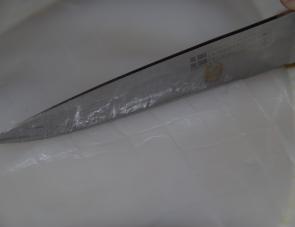
If stir frying or doing salt and pepper squid, I would pineapple (score or cut) the inside of the entire tube with light pressure applied to a sharp knife. Lay the split tube flat, with the outside in contact with the cutting board and cut less than half
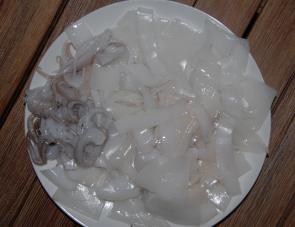
However you like to cook your squid, cleaning it properly will make a big difference to the final result on the plate. Even if I am going to freeze freshly caught squid, I will clean it first before I cryovac it because this will guarantee a clean, untain
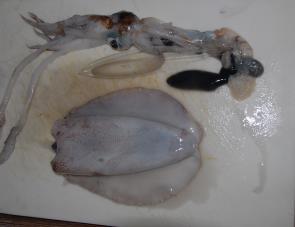
Grab the head, slide your forefinger inside the tube (main squid body) and move it around to break away the guts from the tube. Pull the head to remove the head and guts from the tube. Avoid breaking the black ink sack if possible as this will create quit
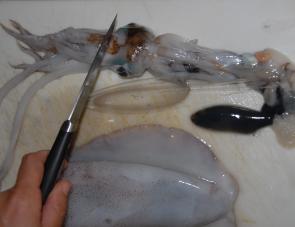
Cut the tentacles away from the main head, a little below the eyes. You may need to remove the centre section out of the cut away tentacles if you still have the beak section in it.
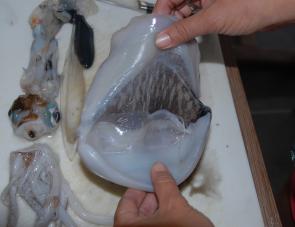
Grab the tube in one hand and one of the wings in the other and pull firmly until the two begin to separate.
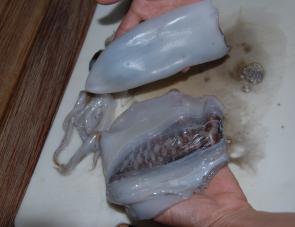
The tube should come away clean like this and you will be left with two pieces: the tube as one piece and the skin with the two wings still attached as the other.

Next we have to extract the meat in the two wings away from the skin. To do this, you will need to grip the wing firmly and then peel the skin off. It may take a couple of attempts to get all the skin off, leaving two clean white wings.
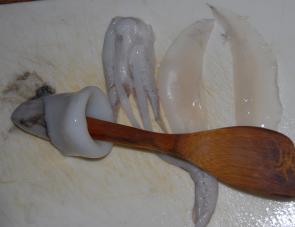
On small squid you will be able to get your fingers in to clean the last of the remnants away from the walls. If cutting into strips, you can split the tube to clean it, however if you want calamari rings, you will need to invert larger squid tubes to cle
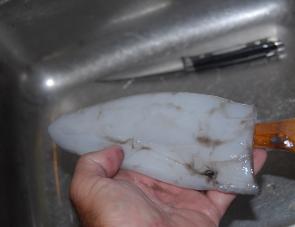
With the tube inverted, clean the last of the thin, skin-like remnants away from the inside if the tube (now on the outside). You will just have to pick these bits away with your fingers. Wash and dry the tube and then invert again so it is back to normal
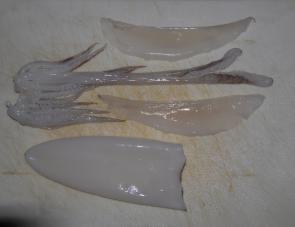
You should now have one entire tube, a cluster of tentacles and two wings. The other pieces can be discarded or kept for addition to the berley trail.




